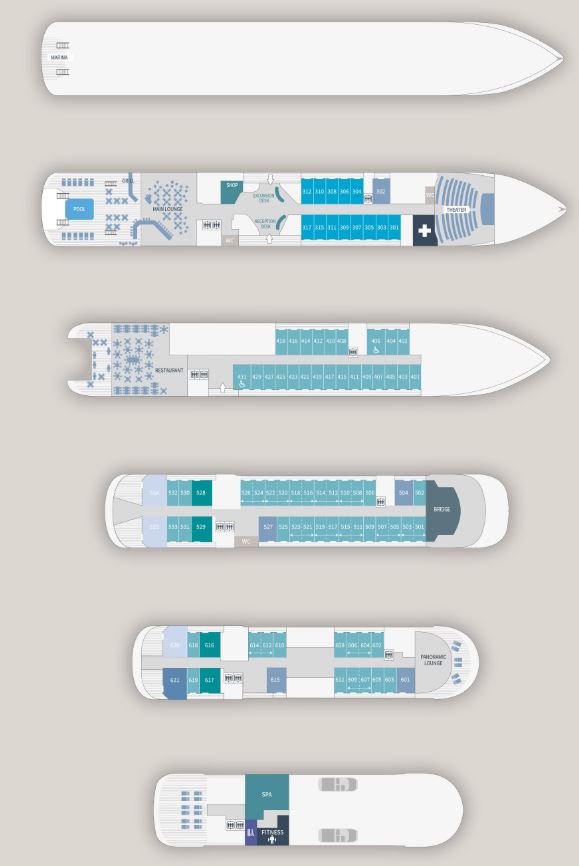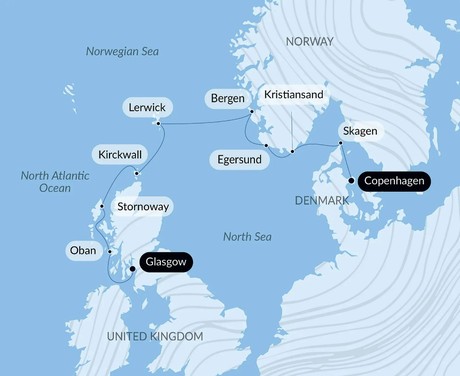Legendary Lands and Northern Cities Luxury Cruise
Set off a bewitching cruise between Celtic and Scandinavian lands, where wild nature and ancient heritage come together. From one port of call to the next, the jagged coasts of Scotland and the peaceful Nordic coastlines, bathed in light that is popular with painters, will reveal their unique history. You will discover mysterious megaliths, valleys sculpted by ancient volcanos and Scandinavian cities steeped in history, veritable open-air museums. During this interlude combining raw nature, legends and living culture, you will experience the tranquillity of isolated coasts, the warmth of small ports and the authenticity of preserved traditions.
Highlights
• The legendary landscapes of the islands in the north of Scotland (spectacular valleys, lochs, lush moors, etc.) and Nordic cities with fascinating heritage (including Bergen, Skagen and Copenhagen).
• UNESCO World Heritage Sites: the Ring of Brodgar from Kirkwall; the Shetland Global Geopark; the Heart of Neolithic Orkney; Bergen and its Hanseatic district.
• A few of the included excursions: the Highlands and Glen Coe Valley from Oban; the Calanais Standing Stones from Stornoway; a visit of Bryggen from Bergen, etc.
In the heart of the Clyde Valley, the bustling city of Glasgow contrasts starkly with the wild beauty of the surrounding countryside. Scotland's biggest city overflows with landmarks from its extensive artistic heritage and outstanding architectural tradition. The city's chequerboard layout makes walking through the major pedestrian thoroughfares easy: go with the flow and let the lively street atmosphere take you past the many Victorian monuments. Don't miss the collections on display in the numerous museums and art galleries. The Kelvingrove Art Gallery and Museum is an outstanding example.
Oban is on the west coast of Scotland, opposite the Isle of Mull. It is the capital of the county of Argyll, a rural region of the Highlands considered to be the cradle of Scotland. Coming from Ireland, the Gaels settled here, bringing their language and culture. From “the Little Bay”, its name in Scottish Gaelic, you will arrive in Kilmartin Glen, the site renowned for having the largest concentration of Neolithic and Bronze Age remains in Scotland. Among this spectacular site’s 350 ancient monuments, you will discover standing stones, alignments of cairns and stone circles. Glen Coe Valley will then reveal its dramatic landscapes, shaped by volcanic activity. This valley, one of the wildest in Scotland, has been used as a location for the series Outlander. The discovery of the region will end with a visit to a whisky distillery, a unique opportunity to taste an exceptional product.
Discover Lewis, the largest island of the Hebrides, considered to be the cradle of Gaelic culture. Here, the peat- and heather- covered valleys and lochs stretch on to infinity, and numerous bird colonies have taken up residence in the long, jagged coastlines where. Not far from Stornoway, the island’s main town, built by the Vikings in the 9th century stands one of Scotland’s most prominent prehistoric sites: The Standing Stones of Callanish. Dating back to more than 3,000 years B.C., these imposing stones placed in a cruciform pattern were laid out according to the moon and stars and their main purpose was to keep track of seasonal cycles, as this was essential for farmers at the time.
Capital of the Orkney archipelago, Kirkwall, which means “church bay”, is an ideal stopover before continuing on to the Northern Isles. Sheltered in a wide bay, the lively town welcomes the visitor with its charming paved alleyways edged by old houses and craft shops. Tankerness House, the oldest homestead in the town, is a must-see landmark. But the true architectural treasure of the aptly named Kirkwall is none other than its remarkable red and gold stone cathedral. And because whisky is inseparable from Scotland’s identity, stop at the Highland Park Distillery for a highly instructive visit.
The small and charming capital of the Shetland Islands, with its sea front of old houses and narrow streets, offering travellers its old districts and a warm port atmosphere. Geopark Shetland, a UNESCO World Heritage Site, is located to the north. Incredibly well-preserved archaeological sites and ruins prove that the islands’ occupation dates back to the first Neolithic colonies. The Shetland Museum and Archives recounts the Shetlands’ history of heritage and culture: Lerwick’s abundant waters were even fished by the Dutch in the past.
Located at the end of Byfjord, Bergen was the capital of Norway in the 12th and 13th Centuries and has preserved some very beautiful monuments from the time when it was home to royalty. Wandering through Bergen’s streets means going back in time, in search of the hidden treasures that have been listed as World Heritage Sites by UNESCO. A veritable openair museum, Bergen is home to a thriving artistic community of painters, potters, jewellers. The Bergen cable car offers you a splendid panorama over the port and the surrounding fjords. Do not miss the visit to the old quarter with its narrow streets, a testimony of the power of the hanseatic League that controlled trade in Northern Europe at the end of the Middle Ages.
Like a painter’s palette, the former industrial town of Egersund unveils its colours as if to better charm its passing visitors. Its small wooden houses, among the best conserved in Norway, certainly display colourful façades that distinguish them from the other municipalities of the southern Norwegian coast, which opted for white at a time when this was a sign of wealth. Admire the façades of Strandgaten, the former main street of the town, and wander the old district of Hauen, which is now full of cafés, galleries and boutiques. Also make a detour to the Heidningeholmen Church, whose foundations date back to the 17th century, and dive into Egersund’s past.
Located in the region of Sørlandet, the town of Kristiansand has prospered for a long time from its building industry and shipbuilding installations. Today, the town offers its timeless charm and mild climate the whole year round. You’ll be amazed by its vibrant pastel colours, and its streets laid out in right angles. Among the districts worth exploring is Posebyen with its wooden houses inhabited in the olden days by workers and craftsmen. Here you can really get to grips with the town’s energy.
Located on the Jutland peninsula at the tip of Denmark, where the North Sea and the Baltic Sea come together, the charming seaside resort of Skagen will enchant you with its immense white sandy beaches and its magnificent dune landscapes. The site is renowned for its extraordinary light and, at the end of the 19th century, was home to many Scandinavian artists, known as the Skagen Painters. Many of their works are exhibited in the town’s museum today. These paintings, realist representations of the area’s stunning natural setting, also provide an opportunity to discover how the inhabitants of this small fishing port lived in the last century.
Connected to the far eastern side of Sealand island, a few kilometres away from the Swedish coasts, Copenhagen offers you the high colour of Scandinavian capitals. You can discover the city's riches that weaves through the canal networks through the historical districts of Christiansborg and Nyhavn. Many palaces provide an apercu of Danish history. For eating, you can try out the smorrebrod, traditional danish sandwiches made with ham, cheese or smoked fish.
Itineraries are subject to change.
|
Book now |
Deluxe Stateroom

Prestige Deck 4

Prestige Deck 5

Prestige Deck 6

Deluxe Suite Deck 3

Deluxe Suite Deck 4

Deluxe Suite Deck 5

Deluxe Suite Deck 6

Prestige Deck 5 Suite

Prestige Deck 6 Suite

Privilege Suite Deck 5

Privilege Suite Deck 6

Grand Deluxe Suite Deck 5

Grand Deluxe Suite Deck 6

Vessel Type: Luxury
Length: 127 metres
Passenger Capacity: 92 cabins
Built: 2017/2018
Featuring innovative and environmentally-friendly equipment, elegantly designed cabins, spacious suites with large windows, and lounge areas that open onto the outside, this new limited-capacity yacht boasting just 92 cabins and suites will offer you a truly unique cruising experience.
As the first ship in a new series, Le Champlain will embody the unique atmosphere that is the cruise line’s hallmark: a subtle blend of refinement, intimacy and comfort.
Aboard this ship that flies the French flag, you will experience the incomparable pleasure of an intimate cruise, with the possibility of exploring an ever-increasing range of destinations in an ethnic-chic ambiance with luxury service.
Experience a luxurious setting where the accent is on authenticity and passion for travel.
RESTAURANTS
As it is an essential part of French culture, gastronomy will naturally have pride of place aboard this new ship. Through its two restaurants, Le Champlain will invite you on a journey to elegance and epicureanism.
In a relaxed atmosphere, a first dining area located on Deck 3 and able to seat 70 will serve grilled meats daily, along with a variety of salads and desserts.
To the back of Deck 4, you will find a 260 m² panoramic restaurant which can accommodate all of our passengers in a single sitting. Designed differently to that on our other ships, this dining area, which opens onto the outside, will have a buffet of salads, desserts and cheeses at your disposal. Our discreet and attentive crew will provide table service for hot meals.
PUBLIC AREAS
Like Le Boréal and its sisterships, Le Champlain has many common areas that are designed and equipped to meet all of your needs while preserving the intimacy of each passenger.
A 140 m² reception area includes: A reception/concierge desk, An excursions desk, The ship’s administrative services, The sales office, manned by our Guest Relations Officer, Our 50 m² boutique which sells clothing, jewellery, beauty products, postcards and various accessories, Toilets accessible to passengers with reduced mobility.
A new hydraulic platform with adjustable height provides: Easier boarding than on any other cruise ship, Easier Zodiac embarkation and disembarkation for expeditions, Easier access to the sea for swimming and practising various water sports such as kayaking or paddle-boarding.
A pool deck offering: A pool with a panoramic view, equipped with a counter-current swimming system, A pleasant solarium, An outdoor bar and lounge with armchairs and sofas.
A 200 m² main lounge which can accommodate all of our passengers to share convivial moments and to host activities organised during the day or evening.
Lastly, a theatre that seats 188, equipped with: The latest sound and lighting technology, A LED wall as the stage backdrop, for the projection of high-resolution images and videos.





Special Offer
Online prices reflect the current brochure fare savings of up to 30%. Prices may change based on demand. Terms and conditions apply. This special offer is subject to availability. Please contact us for more details.
Inclusions
• Accommodation in stateroom
• The full meal plan
• The Open Bar: beginning with boarding, and during the duration of the cruise, a wide selection of drinks (mineral water, soft drinks, wine, beer, champagne, spirits, coffee, tea) is served on request and at any time of the day. Certain premium alcoholic beverages on the menu are not included in the Open Bar
• Free Wi-Fi internet access 24 hours a day*
• Activities offered during expedition cruises (see section "Expedition cruises")
• Access to all the common areas on board our sister ships and Ponant Explorers: fitness room, steam room, hair salon, swimming pool (sea water, heated), solarium, lounges, theater, boutique & leisure area
Exclusions
• Flights other than those mentioned in the itinerary
• Travel insurance
• Passport and visa costs if applicable
• Premium beverages package (Can be purchased on board)
• Optional Excursions where applicable
• Spa treatments on board
• Pre and post cruise accommodation unless otherwise stated
• Transfers unless specified
• Gratuities
Our Associates Include














